
exam revision
CELL:
A cell is a living organism.
Cells are the basic building blocks of all living things.
parts of a cell include:
-nucleus
-midbrain
-cell wall
-nucleus membrane
-cytoplasm
-DNA
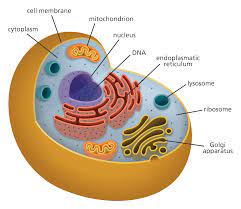 characteristics of living thigs.
characteristics of living thigs.
movement
respiration
growth
reproduction
nutrition
excretion
sensitivity
Cell theory:
-refers to the idea that cells are the basic unit of structure in every living thing.
-all organisms are composed of more than one cell.
-all cells come from preexisting cells.
Prokaryote and Eukaryote: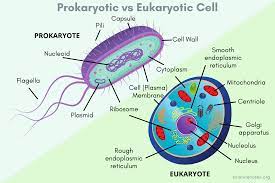
Prokaryote:
are organism made of a single prokaryotic cell.
-bacteria and Archaea are prokaryote
-they are very small cell with simple structure
-they do not have a nucleus (meaning that their DNA is not enclosed inside the cell.
-the DNA is in a single loop and floats in the cytoplasm.

Eukaryotic cell:
are more complex cells.
-it DNA is found in a nucleus
-the nucleuses is an organelle
-they are organisms made of one or more eukaryotic cells
-eg: plants, animals.
ORGANELLE’S are : a structure that perform specific functions.
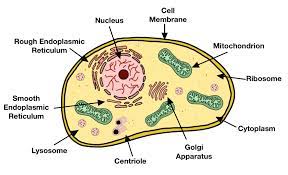
membrane-bound organelle :
an organelle that has a membrane surrounding it
ATP:
adenosine triphosphate is an organic molecule that acts as the main energy carrier in cells.
all cells make ATP but the process ofmaking it can be different
NADPH
nicotinamide adenine dinucleotide photosphere
-is an energy carrier that functions in a comparable way.
organelle names
(1) nucleuses
where ribosome can be produces
(2) nucleus ]
hold the genetic material. (DNA) found in a eukaryotic cell.
(3) ribosome
make protein from amino acids in cytoplasm.
they can be free in the cytoplasm.
(4) vesicle
small sac formed by a membrane and filled with liquid
(5) rough endoplasmic reticulum
Protein production; in particular for export out of the cell
(6) Golgi apparatus
the Golgi is the mailroom that sends our product to customers.
It is responsible for packing proteins from the rough endoplasmic reticulum into membrane-bound vesicles which then translocate to the cell membrane.
(7) cytoskeleton
(8) smooth endoplasmic reticulum
Lipid production; Detoxification
(9) mitochondria
Energy production
Mitochondria are also somewhat unique in that they are self-replicating and have their own DNA
ATP (adenosine triphosphate) is the energy currency of the cell, and is produced in a process known as cellular respiration. Though the process begins in the cytoplasm, the bulk of the energy produced comes from later steps that take place in the mitochondria.
uses glues +oxygen to create = carbon dioxide
+ water +ATP.
cellular respiration:
the process by which cells extract in the form of ATP from energy rich molecules such as glucose.
reparation is an exergonic chemical process that is accompanied by the reals of energy.
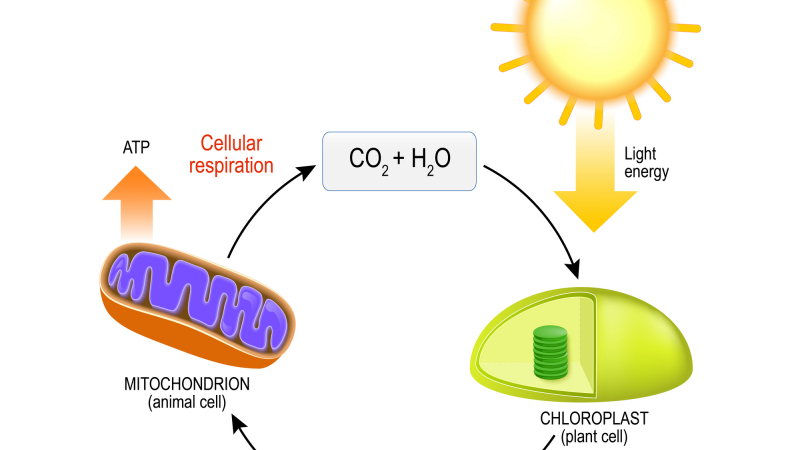
(10) vacuole
are used for storage of material. Aswell as nutrients
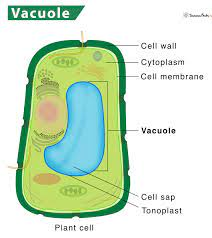
(11) cytosol
(12) lysosome
sacs filled with digestive enzyme’s.
(13) centriole.
(14) cell wall
-found in plant cells only
-provide additional protection.
(15) chloroplast’s
-found in plant cells
function: make glucose using light energy.
- they tend to have a green look because they have a piment that captures light energy.

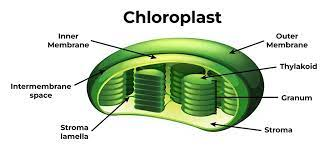
(16) photosynthesis
the process by which plants use sunlight, water, and carbon dioxide to create oxygen and energy in the form of sugar.
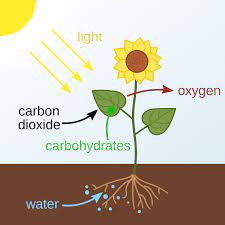
stages of photosynthesis:
light independent reactions:
use light energy and water to produce ATP.
light dependent reactions:
uses ATP, NADPH and carbon dioxide to create sugar.
cytoplasm:
formed by cell organelles, excluding the nucleus, and the cytosol
surface area to volume ratio:
a measure that identifies the number of units of surface area available to ‘serve’ each unit of internal volume of a cell, tissues or organism.
The surface area to volume ratio (SA : V) is a measure of the critical balance between the surface area available for substance exchange and the volume of the cell.
The surface area of a cube is given by the equation: SA = 6L2 where L = the length of one side of the cube. The volume of a cube is given by the equation: V = L 3
PLASMA MEMBRANE
the insoluble boundary of living cells that contain the contents of the cell and regulates the movement of substances in the out of the cell.
It is described as ‘selectively permeable’ and ‘differentially permeable’ ad it allows some substances through and not others.
The cell membrane is primarily made up of three things: 1. Phospholipids 2. Cholesterol 3. Proteins
Fluid music:
the movement of the molecule and how it looks.
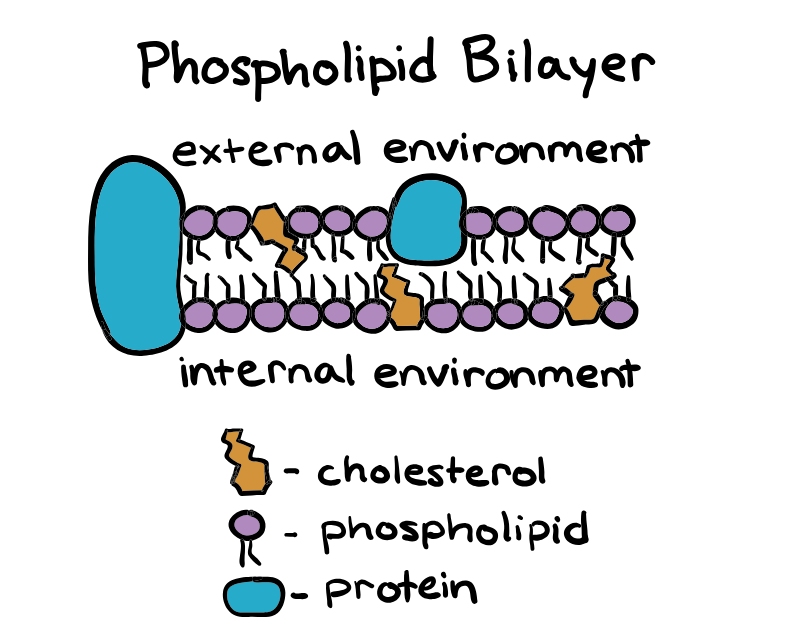

make up the cell membrane. it is a lipid made from glycerol. the head is hydrophilic (water loving) while the tail is hydrophobic (water resistant).
PROTIENS:
channel proteins and carrier proteins:
channel proteins:
tubular shaped, acting as a passageway for the molecules to pass from one side of the membrane to the other. it enables water soluble molecules to pass by facilitated diffusion.
carrier proteins:
bind specific molecules to be transported on one side of the membrane. it uses facilitated diffusion on or active transport.
 cholesterol:
cholesterol:
 Its role is to regulate the membranes consistency.
Its role is to regulate the membranes consistency.
semipermeable: means the barrier allows some molecule to pass through but not. others.
Polar and non-Polar:
Polar means the electrons are not evenly distributed, making one side of the molecule more positively charged or negatively charged than another side.
Nonpolar means the electrons are evenly distributed, so the molecule is evenly charged across the surface.
PASSIVE TRANSPORT ACROSS THE MEMBRANE:
diffusion:
is the movement of molecules from higher concentration to lower concentration. it does not require energy. (passive) diffusion is dependent on the concentration gradient.
molecules ex:
carbon dioxide
oxygen
other small non-polar molecules
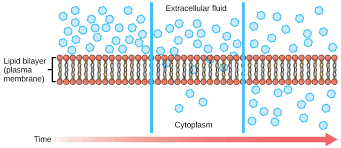
simple diffusion:
molecules move across the membrane without assistance.
eg: lipids
oxygen
C02
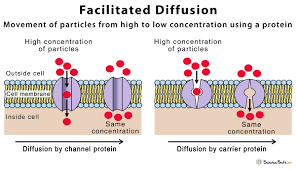
carrier - mediated facilitated diffusion:
allows large lipids insoluble molecules that cannot cross the membrane through simple diffusion.
ex:
glucose
channel mediated facilitated diffusion:
hydrophilic pores allow inorganic ions to pass through the membrane.
ex:
inorganic ions
OSMOSIS:
the diffusion of water molecules from a lower solute concentration to a higher solute concentration.
ACTIVE TRANSPORT ACROSS THE MEBRAIN:
energy is used to move particles through a membrane against a connection gradient.
Vesical:
are small sacs from the plasma membrane. the formational and movement of these vesical are referred to as cytosis. cytosis not only move substances in, out of, and through cells, but also add and subtract membrane from the cell's plasma membrane.

endocytosis: Cellura uptake of substances from the environment via vesical formation
exocytosis: cellular release of substances to the environment via vesical formation.
Primary active transport: direct uses ATP fir the energy to transport molecules
secondary active transport: energy is stored in a concentration gradient.
concentration gradient is the degree of concentration.
TONICITY: strength of a solution.
Hypo: less strong than the solution of the cell.
Iso: same on either side.
hyper: if the concentration of solutes is higher compared to inside the cell.
solute: what dissolves in the water
solvent: the substance that dissolves other substances(water)
concentration gradient: the difference in the solute levels (concentration) between adjacent areas.
equilibrium: equal solute concentration on both sides of the membrain
polar: has a charge
why do cells divide?
growth:
we started as a sperm and egg to 37.3 trillion cells
repair: if you get a cut in your skin, overtime it heals.
Asexual reproduction: how simple organism give rise to their offspring
Bonary fiision:
is an asexual reproduction process in prokaryotes and single-celled eukaryotes, where bacterial cells replicate their DNA, form a wall, and divide into two cells.
mitosis:
The process by which a cell replicates its chromosomes and then segregates them, producing two identical nuclei in preparation for cell division.
phases: PMAT
prophase, metaphase, anaphase, telophase.
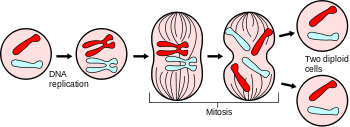 Phases:
Phases:
interphase: refer to event between mitosis. the cell replicates the nuclear material ready
prophase is divided into two:
Early prophase: mitotic spindle starts to form, the chromosomes start to condense, and the nucleolus disappears.
late prophase: the mitotic spindle begins to capture and organize the chromosomes.
Metaphase:
some spindle fibers attach to and organize the chromosome on the equator of the cell (middle). some spindle fibers span the cell.
Anaphase: Spindle fiber attached to chromatids shorten, pulling the chromatids apart.
telophase: The new nuclei form. A furrow forms across the middle of the parent cell pinching it in two.
cytokinesis: physical process of cell division, which divides the cytoplasm of a parental cell into two daughter cells.



 .
.
Binary fission: mitosis for bacterial cells
a type of asexual reproduction typically observed in prokaryotes and a few single-celled eukaryotes. The division of the parent body into two, fairly equal, part to produce two identical cells
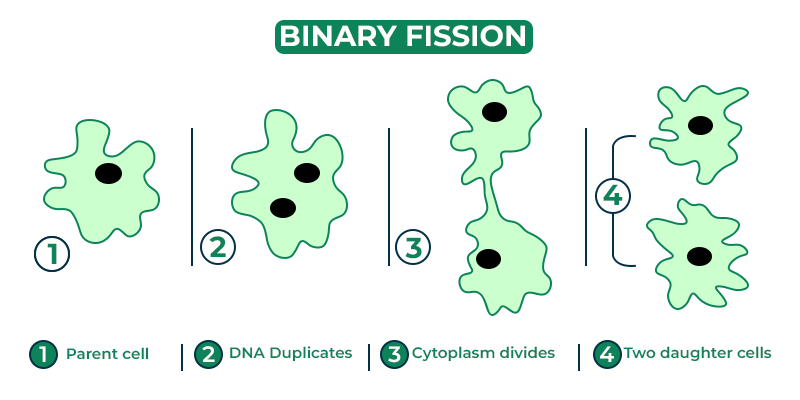 CELL CYCLE:
CELL CYCLE:
interphase: is the time when the cell is not dividing.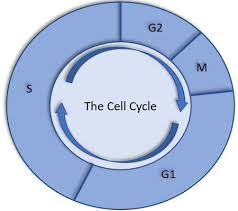
G1: cell growth, protein production and some organelles
S-phase: growth and DNA replication in perpetration for nuclear division
G2: growth and preparation for mitosis. it stores energy and all of the other organelles have to be replicated.
G0: when a cell does not need to undergo mitosis it may go into G0 phase.
CELL REGULATION:
our cell have a control system to check whether all the important processes have been performed correctly before moving into the next phase.
there are 3 checkpoints:
checkpoints: is a critical regulatory point in the cell cycle.
G1 checkpoint
G2 checkpoint
M checkpoint
G1 checkpoint:
pass the checkpoint if:
cell size is large enough
sufficient nutrients are available
signals from other cells have been received.
G2 checkpoint:
pass the checkpoint if:
cell size i large enough
replication of chromosomes has been successfully completed
protein required for mitosis have been synthesized.
Metaphase checkpoint:
pass the checkpoint if:
all chromosomes are attacked to the mitotic spindle.
APOPTOSIS
also known as Programmed cell death, is a controlled process that eliminates faulty and infected cells from the body through a sequence of events.
Cell goes through a sequence of events:
1. Cell volume decreases and start shrinking.
2. Cell develops blebs (bubbles) at the membranes.
3. Nucleus gets fragmented.
4. Cell debris (or broken cell parts) removed by macrophages
 Disrupting the cell cycle:
Disrupting the cell cycle:
Cell cycle is strictly controlled, and failure of this control mechanism can disrupt the Cell Cycle.
The disruption of the cell cycle, caused by mutations in genes or chemical exposure, can lead to abnormal embryo development or tumor formation.
Mutagen:
is a substance or agent that courses DNA impairment that result in the alternation of DNA sequence.
e.g. bacteria, virous, and UV
carcinogens:
Carcinogens are mutations that cause cancer, as damaged cells fail to meet checkpoint requirements, causing rapid cell division and tumor formation.
Tumor:
are large masses of cancerous cell.
Cancerous cells evade the cell cycle checkpoint and divide rapidly coursing tumor.
Two types of genes control the cell cycle:
proto-oncogenes: which initiate cell division.
tumor-suppressor genes: which prevent division in response to DNA or cell damage.
oncogenes:
Mutations in genes regulating cell cycle can lead to negative consequences, such as oncogenes causing uncontrollable cell division and tumor-suppressor genes initiating most human cancers.
STEM CELLS:
are undifferentiated cells found in multicellular organisms. they are characterized by the properties of self-renewal and potency. they are unspecialized cells that can divide repeatedly while remaining unspecialized.
the two properties of stem cells are:
self-renewal: have the ability to divide many times while maintaining an unspecialized states.
potency: the ability to differentiate (transom) into specialized cells, there are different potency that depends on the type of stem cell.
types of stem cells:
EMBRYONIC STEM CELS:
are derived from the inner mass of blastocyst. cells derived from the inner cell mass are pluripotent meaning they can become any cell of the body with the exception of placental cells.
Totipotent stem cells, (high or most potency) found in zygotes, can differentiate into any cell in an organism.
Pluripotent stem cells: (high potency) can divide into most, or all, cell types in an organism, but cannot develop into an entire organism on their own.their ability to form all three of the basic body layers (ectoderm/endoderm/mesoderm) and even germ cells.
Adult stem cells: Multipotent least potency
Adult stem cells are undifferentiated cells found in several types of tissues like the brain and bones, that can differentiate into a small number of cell types usually related to the tissues or organs, as they are multipotent,
Adult stem cells, such as bone marrow and epithelial cells, differentiate into a limited number of tissue cell types, aiding in repair and replacement, but challenging to isolate and treat medical conditions.
Germ layers:
After the blastocyst implants, it forms a 'Gastrula', which undergoes changes to form germ layers, where stem cells differentiate into specific types.
exam revision
CELL:
A cell is a living organism.
Cells are the basic building blocks of all living things.
parts of a cell include:
-nucleus
-midbrain
-cell wall
-nucleus membrane
-cytoplasm
-DNA
 characteristics of living thigs.
characteristics of living thigs.
movement
respiration
growth
reproduction
nutrition
excretion
sensitivity
Cell theory:
-refers to the idea that cells are the basic unit of structure in every living thing.
-all organisms are composed of more than one cell.
-all cells come from preexisting cells.
Prokaryote and Eukaryote:
Prokaryote:
are organism made of a single prokaryotic cell.
-bacteria and Archaea are prokaryote
-they are very small cell with simple structure
-they do not have a nucleus (meaning that their DNA is not enclosed inside the cell.
-the DNA is in a single loop and floats in the cytoplasm.

Eukaryotic cell:
are more complex cells.
-it DNA is found in a nucleus
-the nucleuses is an organelle
-they are organisms made of one or more eukaryotic cells
-eg: plants, animals.
ORGANELLE’S are : a structure that perform specific functions.

membrane-bound organelle :
an organelle that has a membrane surrounding it
ATP:
adenosine triphosphate is an organic molecule that acts as the main energy carrier in cells.
all cells make ATP but the process ofmaking it can be different
NADPH
nicotinamide adenine dinucleotide photosphere
-is an energy carrier that functions in a comparable way.
organelle names
(1) nucleuses
where ribosome can be produces
(2) nucleus ]
hold the genetic material. (DNA) found in a eukaryotic cell.
(3) ribosome
make protein from amino acids in cytoplasm.
they can be free in the cytoplasm.
(4) vesicle
small sac formed by a membrane and filled with liquid
(5) rough endoplasmic reticulum
Protein production; in particular for export out of the cell
(6) Golgi apparatus
the Golgi is the mailroom that sends our product to customers.
It is responsible for packing proteins from the rough endoplasmic reticulum into membrane-bound vesicles which then translocate to the cell membrane.
(7) cytoskeleton
(8) smooth endoplasmic reticulum
Lipid production; Detoxification
(9) mitochondria
Energy production
Mitochondria are also somewhat unique in that they are self-replicating and have their own DNA
ATP (adenosine triphosphate) is the energy currency of the cell, and is produced in a process known as cellular respiration. Though the process begins in the cytoplasm, the bulk of the energy produced comes from later steps that take place in the mitochondria.
uses glues +oxygen to create = carbon dioxide
+ water +ATP.
cellular respiration:
the process by which cells extract in the form of ATP from energy rich molecules such as glucose.
reparation is an exergonic chemical process that is accompanied by the reals of energy.

(10) vacuole
are used for storage of material. Aswell as nutrients

(11) cytosol
(12) lysosome
sacs filled with digestive enzyme’s.
(13) centriole.
(14) cell wall
-found in plant cells only
-provide additional protection.
(15) chloroplast’s
-found in plant cells
function: make glucose using light energy.
- they tend to have a green look because they have a piment that captures light energy.


(16) photosynthesis
the process by which plants use sunlight, water, and carbon dioxide to create oxygen and energy in the form of sugar.

stages of photosynthesis:
light independent reactions:
use light energy and water to produce ATP.
light dependent reactions:
uses ATP, NADPH and carbon dioxide to create sugar.
cytoplasm:
formed by cell organelles, excluding the nucleus, and the cytosol
surface area to volume ratio:
a measure that identifies the number of units of surface area available to ‘serve’ each unit of internal volume of a cell, tissues or organism.
The surface area to volume ratio (SA : V) is a measure of the critical balance between the surface area available for substance exchange and the volume of the cell.
The surface area of a cube is given by the equation: SA = 6L2 where L = the length of one side of the cube. The volume of a cube is given by the equation: V = L 3
PLASMA MEMBRANE
the insoluble boundary of living cells that contain the contents of the cell and regulates the movement of substances in the out of the cell.
It is described as ‘selectively permeable’ and ‘differentially permeable’ ad it allows some substances through and not others.
The cell membrane is primarily made up of three things: 1. Phospholipids 2. Cholesterol 3. Proteins
Fluid music:
the movement of the molecule and how it looks.


make up the cell membrane. it is a lipid made from glycerol. the head is hydrophilic (water loving) while the tail is hydrophobic (water resistant).
PROTIENS:
channel proteins and carrier proteins:
channel proteins:
tubular shaped, acting as a passageway for the molecules to pass from one side of the membrane to the other. it enables water soluble molecules to pass by facilitated diffusion.
carrier proteins:
bind specific molecules to be transported on one side of the membrane. it uses facilitated diffusion on or active transport.
 cholesterol:
cholesterol:
 Its role is to regulate the membranes consistency.
Its role is to regulate the membranes consistency.
semipermeable: means the barrier allows some molecule to pass through but not. others.
Polar and non-Polar:
Polar means the electrons are not evenly distributed, making one side of the molecule more positively charged or negatively charged than another side.
Nonpolar means the electrons are evenly distributed, so the molecule is evenly charged across the surface.
PASSIVE TRANSPORT ACROSS THE MEMBRANE:
diffusion:
is the movement of molecules from higher concentration to lower concentration. it does not require energy. (passive) diffusion is dependent on the concentration gradient.
molecules ex:
carbon dioxide
oxygen
other small non-polar molecules

simple diffusion:
molecules move across the membrane without assistance.
eg: lipids
oxygen
C02

carrier - mediated facilitated diffusion:
allows large lipids insoluble molecules that cannot cross the membrane through simple diffusion.
ex:
glucose
channel mediated facilitated diffusion:
hydrophilic pores allow inorganic ions to pass through the membrane.
ex:
inorganic ions
OSMOSIS:
the diffusion of water molecules from a lower solute concentration to a higher solute concentration.
ACTIVE TRANSPORT ACROSS THE MEBRAIN:
energy is used to move particles through a membrane against a connection gradient.
Vesical:
are small sacs from the plasma membrane. the formational and movement of these vesical are referred to as cytosis. cytosis not only move substances in, out of, and through cells, but also add and subtract membrane from the cell's plasma membrane.

endocytosis: Cellura uptake of substances from the environment via vesical formation
exocytosis: cellular release of substances to the environment via vesical formation.
Primary active transport: direct uses ATP fir the energy to transport molecules
secondary active transport: energy is stored in a concentration gradient.
concentration gradient is the degree of concentration.
TONICITY: strength of a solution.
Hypo: less strong than the solution of the cell.
Iso: same on either side.
hyper: if the concentration of solutes is higher compared to inside the cell.
solute: what dissolves in the water
solvent: the substance that dissolves other substances(water)
concentration gradient: the difference in the solute levels (concentration) between adjacent areas.
equilibrium: equal solute concentration on both sides of the membrain
polar: has a charge
why do cells divide?
growth:
we started as a sperm and egg to 37.3 trillion cells
repair: if you get a cut in your skin, overtime it heals.
Asexual reproduction: how simple organism give rise to their offspring
Bonary fiision:
is an asexual reproduction process in prokaryotes and single-celled eukaryotes, where bacterial cells replicate their DNA, form a wall, and divide into two cells.
mitosis:
The process by which a cell replicates its chromosomes and then segregates them, producing two identical nuclei in preparation for cell division.
phases: PMAT
prophase, metaphase, anaphase, telophase.
 Phases:
Phases:
interphase: refer to event between mitosis. the cell replicates the nuclear material ready
prophase is divided into two:
Early prophase: mitotic spindle starts to form, the chromosomes start to condense, and the nucleolus disappears.
late prophase: the mitotic spindle begins to capture and organize the chromosomes.
Metaphase:
some spindle fibers attach to and organize the chromosome on the equator of the cell (middle). some spindle fibers span the cell.
Anaphase: Spindle fiber attached to chromatids shorten, pulling the chromatids apart.
telophase: The new nuclei form. A furrow forms across the middle of the parent cell pinching it in two.
cytokinesis: physical process of cell division, which divides the cytoplasm of a parental cell into two daughter cells.



 .
.
Binary fission: mitosis for bacterial cells
a type of asexual reproduction typically observed in prokaryotes and a few single-celled eukaryotes. The division of the parent body into two, fairly equal, part to produce two identical cells
 CELL CYCLE:
CELL CYCLE:
interphase: is the time when the cell is not dividing.
G1: cell growth, protein production and some organelles
S-phase: growth and DNA replication in perpetration for nuclear division
G2: growth and preparation for mitosis. it stores energy and all of the other organelles have to be replicated.
G0: when a cell does not need to undergo mitosis it may go into G0 phase.
CELL REGULATION:
our cell have a control system to check whether all the important processes have been performed correctly before moving into the next phase.
there are 3 checkpoints:
checkpoints: is a critical regulatory point in the cell cycle.
G1 checkpoint
G2 checkpoint
M checkpoint
G1 checkpoint:
pass the checkpoint if:
cell size is large enough
sufficient nutrients are available
signals from other cells have been received.
G2 checkpoint:
pass the checkpoint if:
cell size i large enough
replication of chromosomes has been successfully completed
protein required for mitosis have been synthesized.
Metaphase checkpoint:
pass the checkpoint if:
all chromosomes are attacked to the mitotic spindle.
APOPTOSIS
also known as Programmed cell death, is a controlled process that eliminates faulty and infected cells from the body through a sequence of events.
Cell goes through a sequence of events:
1. Cell volume decreases and start shrinking.
2. Cell develops blebs (bubbles) at the membranes.
3. Nucleus gets fragmented.
4. Cell debris (or broken cell parts) removed by macrophages
 Disrupting the cell cycle:
Disrupting the cell cycle:
Cell cycle is strictly controlled, and failure of this control mechanism can disrupt the Cell Cycle.
The disruption of the cell cycle, caused by mutations in genes or chemical exposure, can lead to abnormal embryo development or tumor formation.
Mutagen:
is a substance or agent that courses DNA impairment that result in the alternation of DNA sequence.
e.g. bacteria, virous, and UV
carcinogens:
Carcinogens are mutations that cause cancer, as damaged cells fail to meet checkpoint requirements, causing rapid cell division and tumor formation.
Tumor:
are large masses of cancerous cell.
Cancerous cells evade the cell cycle checkpoint and divide rapidly coursing tumor.
Two types of genes control the cell cycle:
proto-oncogenes: which initiate cell division.
tumor-suppressor genes: which prevent division in response to DNA or cell damage.
oncogenes:
Mutations in genes regulating cell cycle can lead to negative consequences, such as oncogenes causing uncontrollable cell division and tumor-suppressor genes initiating most human cancers.
STEM CELLS:
are undifferentiated cells found in multicellular organisms. they are characterized by the properties of self-renewal and potency. they are unspecialized cells that can divide repeatedly while remaining unspecialized.
the two properties of stem cells are:
self-renewal: have the ability to divide many times while maintaining an unspecialized states.
potency: the ability to differentiate (transom) into specialized cells, there are different potency that depends on the type of stem cell.
types of stem cells:
EMBRYONIC STEM CELS:
are derived from the inner mass of blastocyst. cells derived from the inner cell mass are pluripotent meaning they can become any cell of the body with the exception of placental cells.
Totipotent stem cells, (high or most potency) found in zygotes, can differentiate into any cell in an organism.
Pluripotent stem cells: (high potency) can divide into most, or all, cell types in an organism, but cannot develop into an entire organism on their own.their ability to form all three of the basic body layers (ectoderm/endoderm/mesoderm) and even germ cells.
Adult stem cells: Multipotent least potency
Adult stem cells are undifferentiated cells found in several types of tissues like the brain and bones, that can differentiate into a small number of cell types usually related to the tissues or organs, as they are multipotent,
Adult stem cells, such as bone marrow and epithelial cells, differentiate into a limited number of tissue cell types, aiding in repair and replacement, but challenging to isolate and treat medical conditions.
Germ layers:
After the blastocyst implants, it forms a 'Gastrula', which undergoes changes to form germ layers, where stem cells differentiate into specific types.
 Knowt
Knowt